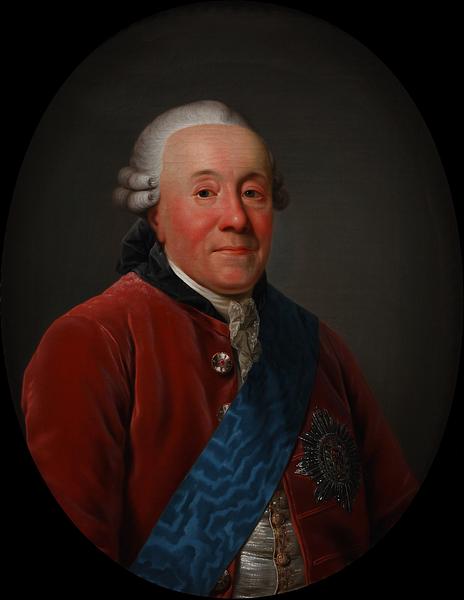Count Jørgen Scheel (1718–1786) was one of the most prominent noblemen and landowners in Denmark in the last half of the eighteenth century. He knew how to navigate courtly circles and distinguished himself as a prominent official during the reign of Frederik V. In 1742 he was given the title chamberlain, a few years later he became a member of The Privy Council, and in 1749 he was appointed a knight of the Order of the Dannebrog. During the reign of Christian VII, Jørgen Scheel was awarded the Order of the Elephant and appointed Master of the Stables – an important and prestigious position in a time when horses served as the primary means of transport.
[1]Jørgen Scheel had forty-one years of married life with his wife Charlotte Louise, who was also portrayed by Jens Juel in 1781 (
B 345). This was by no means the first time that the couple had their portraits painted: throughout their lives, they were portrayed on several occasions by Denmark’s foremost painters, and each time they wore extremely elegant clothes.
[2] This portrait shows Jørgen Scheel at the age of approximately 63, wearing the red uniform jacket of a chamberlain and a brocade waistcoat underneath. He wears the Order of the Elephant, which emphasises his position among the contemporary elite.
The portrait was executed the year after Juel had returned to Copenhagen from an eight-year trip abroad. By this time he was ranked among the best portrait painters, and his work was in great demand, especially among the nobility. The fact that Juel had been appointed court painter in 1780 also caused his popularity to increase, and this was probably the reason why he was commissioned to paint the portraits of the count and countess Scheel in 1781.
Jørgen Scheel owned the Gammel Estrup manor from 1731 to 1786. It primarily functioned as a summer residence for the couple, who otherwise spent much of their time at the court in Copenhagen. But in 1782 Jørgen Scheel retired, and he spent his last years at Gammel Estrup. Hence, another version of the portrait and its pendant can be seen at the manor. In the eighteenth century, it was not unusual to see several versions of the portraits of royals and the nobility. To meet such demand, Juel – who was one of the most productive portrait painters of the time and had a workshop known as a ‘portrait factory’ – had assistants to help him.
[3]Lent to the exhibitionJens Juel – Under the skin
Kunstmuseum Brandts, Odense, DanmarkFebruary 8 - August 24, 2025
Fuglsang Kunstmuseum, Toreby L., DenmarkSeptember 11, 2025 – January 18, 2026
Ribe Kunstmuseum, Ribe, DenmarkFebruary 7 - May 28, 2026
